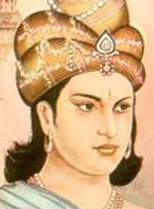
Ashoka's Reign
Born in 294 BC as second son to Bindusar, the King of Patliputra, Ashoka was not heir apparent. After his father died, his elder brother Suman was to take over the reins of the Kingdom. But as most of the ministers found Ashoka more efficient, they helped him attain power.
Ashoka was a good administrator and at first set about restoring peace in his kingdom. This took about 3 years, after which he formally accepted the throne and was crowned King in 273 BC. During his reign, the country made progress in terms of science and technology as well as advanced in medicine and surgery. Religion was emphasized and so the people were honest and straightforward and truthful. Stealing was unheard of.
Ashoka, himself was a great philanthropist and worked day and night for the welfare of his people. He knew exactly what was going on in each part of his vast territory. He would not partake any of his meals until and unless he had fed a thousand Brahmins.
The Kalinga War
This was the first and last battle that Ashoka ever fought and serves as a watermark in his life as it changed his course forever. It was during this war that he earned the title Ashoka the Great.
Kalinga was a prosperous little kingdom lying between the river Godavari and Mahanadi, close to the Bay of Bengal. It had an infantry of 60,000 men, 10,000 horsemen and 600 elephants. Ashoka wanted to capture this fertile land, and so had it surrounded. But the brave and loyal people of Kalinga did not want to lose their independence.
A fierce battle followed, in which there were too many casualties. There were more than a lakh prisoners of war. In the midst of the battlefield, Ashoka stood with the wounded, crippled and the dead all around him. This was the consequence of his greed. A new light dawned on him, and he swore that he would never wage war again.
Ashoka's Conversion
Ashoka was initiated into Buddhism, after which his life was completely transformed. He religiously followed the principles of Buddhism - that of truth, charity, kindness, purity and goodness.
He did his bit towards the propagation of this religion by engraving it's principles on pillars throughout his kingdom. The Ashoka pillars, as they are now called, were over 40 feet high and extremely heavy. He also attempted to spread this religion to Syria, Egypt and Macedonia, and sent his son Mahendra and daughter Sangamitra to Sri Lanka for this purpose.
Ashoka opened charitable hospitals and dispensaries for the welfare of the poor. He planted trees to provide shade and opened inns for the shelter of travelers and laid out green parks and gardens to beautify his kingdom. Wells and tanks were also constructed for the benefit of his people. He believed in non-violence and so he banned the sacrifice of animals. Besides this he opened clinics for birds and animals too. His good works earned him the name of Devanamapriya Priyadarshi.
Ashoka Chakra
He died in 232 BC. After doing a great deal of good for his kingdom and the world at large. His fame has spread far and wide. To commemorate his rule and its implications the Government of India has adopted the Ashoka Chakra as its national symbol, which can be seen till today on the national flag.
No comments:
Post a Comment